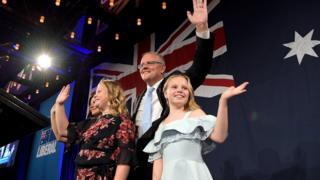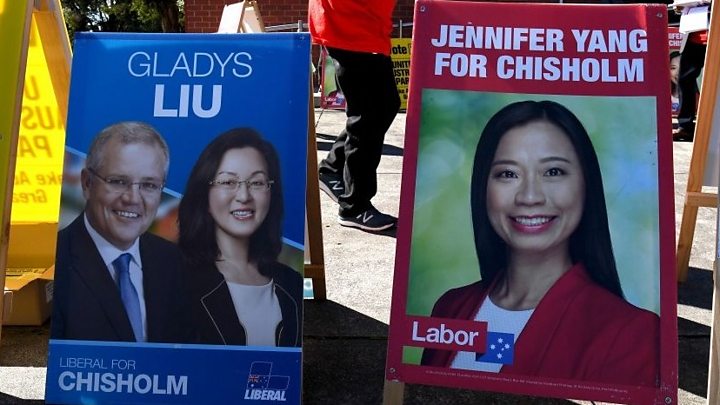Home » Australasia »
Australia coalition wins outright majority
Australian Prime Minister Scott Morrison has secured a majority government, capping off a shock result in Saturday’s election.
With 77.5% of votes counted, the Liberal-National coalition has now reached the 76 seats needed to control the lower house.
The result has defied long-term polls that had predicted a Labor Party win for the first time in six years.
Labor leader Bill Shorten has said he is standing down.
He told members on Saturday night: “We’ve argued for the future and our time will come. Count upon that.”
There are still four seats yet to be declared.
The Liberal Party is leading in two of those seats – Bass in Tasmania and Macquarie in New South Wales – while Labor has a narrow lead in Cowan, West Australia, and in Lilley in Brisbane.
The result represents a comfortable increase from the coalition’s standing prior to the election, where it had fallen into minority government, relying on the support of independents.
On Tuesday, the seat of Chisholm in Victoria was declared for Liberal candidate Gladys Liu, taking the government over the 76-seat threshold.
Ms Liu is the first Chinese-Australian ever to be elected to the lower house.
Why was this outcome such a surprise?
For more than a year, consecutive opinion polls had shown Labor ahead of the government.
The view was that the government’s image had been damaged by successive leadership challenges and the chaotic ousting of Prime Minister Malcolm Turnbull last year, as well as a string of parliamentary scandals.
Mr Morrison, who had only been leader for nine months, went into Saturday’s vote as the underdog.
He campaigned primarily on economic issues, often doing so alone and painting the election as a choice between himself and Mr Shorten.
Labor campaigned on a promise to “stop the chaos” and introduce major changes to climate and economic policy.
But ultimately that failed to appeal to voters and the conservative coalition romped home, collecting seats from Labor with a national 0.5% swing towards it.
“I’ve always believed in miracles,” Mr Morrison told supporters in his victory speech on Saturday.
What were the biggest upsets?
Former Prime Minister Tony Abbott lost his safe seat to an independent candidate, Zali Steggall, ending his 25-year hold on the wealthy Sydney electorate.
However, that was the only real loss for the coalition and it was Labor who suffered the biggest upsets.
The conservatives unexpectedly swept the state of Queensland, where a dozen marginal seats for the House of Representatives were being closely watched.
This gutted Labor’s vote, reducing the party to just five or six seats of the 30 in the state.
The Senate is still key
Hywel Griffith, BBC News, Canberra
After limping through the last few months as a minority government, suffering embarrassing defeats and failing to get legislation through, suddenly the coalition has been born again.
These numbers may not look huge, but they will make a big difference to how Scott Morrison can approach parliament.
Having a majority means he won’t have to garner the favour of cross-benchers nor offer concessions to his opponents.
In theory, there should be far less fire-fighting and far more stable government.
Of course, in practice the two-tier system means legislation still needs to get through the Senate where the coalition isn’t on course for a majority.
And remember, if Australian politics has taught us anything, it is to expect the unexpected – just when it looks like we’re in calm waters often another storm can blow in.
Sorry, your browser cannot display this map
What will Scott Morrison’s government look like?
Mr Morrison has not yet revealed his cabinet. However it will feature many new faces because several Liberal frontbenchers resigned before the election.
The prime minister had promised to pass tax cuts immediately, but he now forecasts delays due to post-election red tape.
He has articulated some other priorities – including an upgrade to a coal plant, and extra funding for non-government schools. However a broader agenda is yet to be defined.
What will happen to Labor?
Much of the post-election analysis has focused on the decline in the party’s traditional blue-collar base, and whether its package of reforms was too ambitious.
Having now lost two consecutive elections, Mr Shorten has stepped aside as the party seeks to remodel itself under a new leader.
Anthony Albanese, who vied for the leadership in 2013 against Mr Shorten, says he will run for the role, as has shadow treasurer Chris Bowen. Frontbenchers Jim Chalmers and Joel Fitzgibbon are also considering a run.
Meanwhile, party deputy Tanya Plibersek, who was another favourite, said on Monday she would not join the contest.
Source: Read Full Article




